| home previous page |
NORLEX |  |
| home previous page |
NORLEX |  |
Derivatio nominis: The name Lysing is derived from the Norwegian word for the fish species Merluccius merluccius or hake.
Publication: Dalland et al. (1988)
Reference well 6506/12-4: 15 slides, of which 14 are core samples and 1 ditch cuttings sample, covering the interval 3129.1 m - 3144.3 m are available at the NPD. Note that these fall in the (+5.9 m) corrected core range of the member.
Reference well 6506/12-4: core #1, interval 3129 m - 3150 m (3142.9 m uncorrected core depth). Note there is at least a +5.9 m core correction to this core.
Reference well 6506/3-1 (new additional reference well): core #1 3101.5 m - 3171.5 m (uncorrected core depth). The lowermost part of the member is cored including the base of the member at 3109.41 m (uncorrected core depth). Note that core #1 has a +1.07 m core to log correction.
6506/12-4:
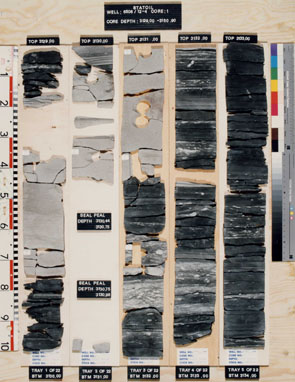 6506/12-4, 3129-3133 m |
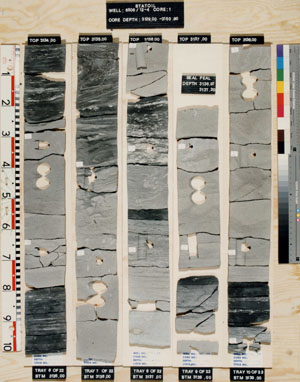 6506/12-4, 3134-3138 m |
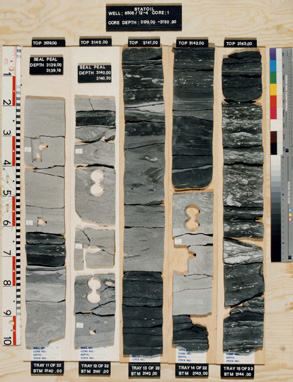 6506/12-4, 3139-3143 m |
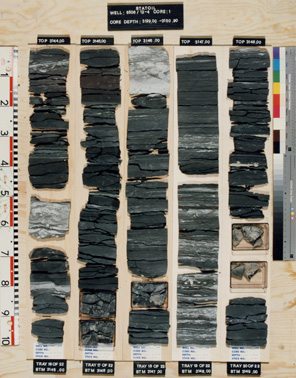 6506/12-4, 3144-3148 m |
6506/3-1 (selected core details only):
Occurrences of member tops in wells
WGS84 coordinates: N 65°27'16.7", E 07°12'52.6"
UTM coordinates: 7260481.16 N 417247.40 E
UTM zone: 32
Drilling operator name: Conoco Norway
Completion date: 01.12.1984
Status: P & A
Interval of type section (m) & thickness in type well:
3000 m - 2926 m, 74 m thickness.
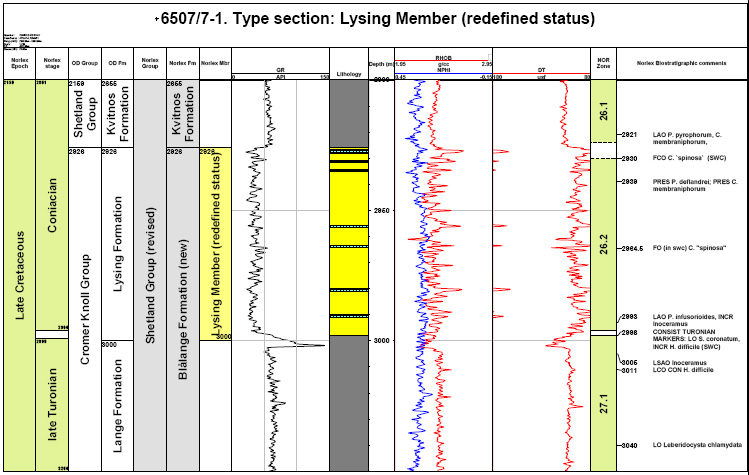
WGS84 coordinates: N 65°12'46.97"N, E 06°43'30.37"
UTM coordinates: 7234298.14 N 393591.29 E
UTM zone: 32
Drilling operator name: Den norske stats oljeselskap a.s. (Statoil AS)
Completion date: 13.08.1985
Status: P & A
Interval of type section (m) & thickness in type well:
3150 m to 3132.5 m, 17.5m thickness. The lower 15 m of the formation are cored,
including the base
at 3142.87 m MD RKB (uncorrected core depth). Note core #1 has a +6.9 m core to log
correction.
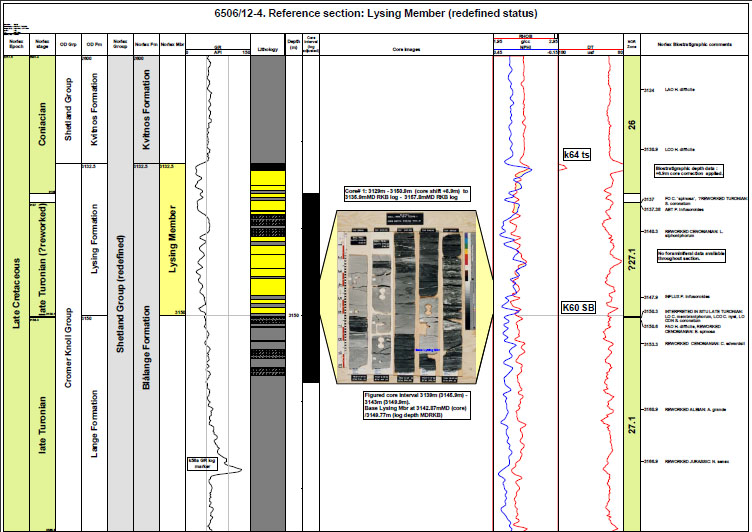
It was considered appropriate to define an additional reference well 6506/3-1 in order to see the log variation within the Lysing Member.
Well name: 6506/3-1
WGS84 coordinates: N 65°48'20.75"N, E 06°44'32.64"
UTM coordinates: 7200300.07 N 396769.02 E
UTM zone: 32
Drilling operator name:Norsk Chevron AS
Completion date: 9.08.2001
Status: P & A
Interval of type section (m) & thickness in type well:
3110.5 m MD RKB (3109.41 m uncorrected core depth) - 3090 m MD RKB, 20.5 m
thickness.
In the type well 6507/7-1, the basal stratotype is defined by a gradual decrease in the gamma-ray log and an upward increase in sonic velocities response at the onset of a more serrate pattern on the resistivity and sonic logs. In other wells, e.g. 6506/6-1, 3080 m MD RKB, the base of the member may be sharp and reflects the abrupt input of sandstones. In some instances, the base of the Lysing Member has been defined at a prominent high gamma marker (informal k58a) within the upper part of the Blålange Formation e.g. 6506/12-10 (6580 m MDRKB), but the position of this regional correlative event may be as much as 30 m below the first development of sandstones and is not recommended, e.g. 6506/3-1 (3110.5 m MD RKB). In the type well 6507/7-1 the informal k58a marker is almost coincident with the base of the Lysing Member, presumably due to local erosion at the base of the unit. However, this useful marker, which may represent a synchronous ash bed, provides a means of distinguishing Lysing Member sandstones from older sandstones of the underlying Blålange Formation based only on wireline log information.
A prominent high gamma ray feature (informal k58a event) e.g. 6507/7-1 (3002 m MD RKB) provides a useful and regionally correlatable event below the member.
Planktonic foraminifera are generally absent in the Lysing Member but pyritised diatoms such as Stellarima spp. and radiolarians (cenosphaerid and spumellarian types) are frequent, particularly towards the base.
In the reference well 6506/12-4, the dating maybe confused by reworking, since Triassic palynomorphs are present and suggests a source origin for the sediments. It is uncertain whether the sporadic occurrences of S. coronatum throughout the member are in situ or reworked.
More meaningful biostratigraphic data are derived from the additional reference well 6506/3-1 where LO S. coronatum is in the mudstones immediately below the member (3111.04 m corrected core), but the increase in H. difficile (from 3100 m dc and extending within the lower cored interval of the member to 3108.98 m corrected core) suggests that in this well, the Lysing Member straddles the Turonian-Coniacian boundary if this event can be considered reliable.
Additional, less reliable dinocyst events to constrain the Lysing sandstones are the LO Psaligonyaulax deflandrei, LO Spiniferites porosus and acme C. 'spinosa' in the overlying Kvitnos mudstones and the LO Cyclonephelium membraniphorum either within or below the member.
In summary, it appears that the Lysing Member in the majority of wells appears to be (early) Coniacian age but some sandstones developed within the lower part of the member may be latest Turonian age. This is dependant on location and depositional fill history (see comments on correlation below).
The main sandstones of the Lysing Member are usually (early) Coniacian age but the member may straddle the Turonian/Coniacian stage boundary in some wells. In some instances, the biostratigraphic dating is complicated by syn-sedimentary reworking. This review suggests a considerable reduction in the age uncertainty than presented earlier by Dalland et al. (1988).
For a general overview of the various depositional settings of the Lysing sandstones, the reader is referred to Fugelli and Olsen (2005 a,b). Some details are given in the following summary. In their basin screening study of deep marine reservoirs and associated risk assessment and play fairway analysis of the Vøring and Møre Basins, the Lysing sandstones and time equivalent sediments (K72 sequence) were cited as examples and the main focus for comparison with outcrop analogues from the early Cenozoic Ainsa Basin, Spain and Permian Delaware Basin in Texas, USA. These outcrops studies were used to construct a (composite) shelf-slope to basin floor transect. They documented the seismic character, gross facies elements, reservoir architecture and inferred scale and geometry of the various depositional systems of the Lysing sandstones and time equivalent sediments. They interpreted their K72 sequence as being deposited in medial basin-floor fans within the Vøring Basin (example 2) e.g. 6706/11-1 area; lower slope basin floor fans on the margin of the Trøndelags platform (example 3) e.g. down-dip of 6507/5-3 (Snadd Field) and 6507/2-3 wells; upper slope basin floor fan conduit (example 4) e.g. 6507/5-3 (Snadd Field) representing the main sediment fairway into the down-dip fan complex; slope deposits (example 5) e.g. 6204/11-1; and slope-channel deposits (example 6) e.g. 6204/10-1 located in the Slørebotn sub-basin. Examples 5 and 6 are time equivalent to the Lysing sandstones that are present on the eastern margin of the Møre Basin and are included within the Rødspette Member in this study. In a more area specific study, Fugelli and Olsen (2007) described how the tectonically confined sub-basins on the Dønna Terrace controlled the deposition of the "Lysing Formation". Based on an integrated, multidisciplinary approach, they constructed a detailed depositional model for the deposition of the Lysing sandstones as turbidite complexes within a series of slope (sub) basins.
In terms of details of the sedimentary facies, in the cored 6506/12-4 reference well, located in the Smørbukk Field area, the Lysing Member consists mainly of fine grained sandstones with thin mudstones. The sandstone beds (average thickness 50 cm within a range 17-105 cm) typically have sharp bases and are characterised by fluid escape structures (vertical or inclined pipes and contorted internal structures) suggesting rapid deposition from turbidity currents. However, these sandstones do not show the range of features typically associated with 'classical' turbidites such as the alternation of thin sandstones and mudstones. The sandstones are in some instances interbedded with hemipelagic, generally non- or rarely bioturbated black mudstones with a similar character to those of the underlying interval with rare Planolites, Teichichnus and Zoophycos traces suggesting a relatively deep-water, quiet environmental setting. The boundary with the underlying Blålange mudstones is transitional and does not represent a sharp contact or abrupt facies change. The background mudstones become progressively more bioturbated upwards and sandstone beds appear below the boundary at 3142.87 m MD RKB (uncorrected core depth). This supports the interpretation that the Lysing Member is genetically linked to the Blålange Formation. Elsewhere in the Smørbukk Field area, seven sedimentary facies have been identified from cores within the Lysing Member (Walker unpublished report, 1998) namely, thick structureless sandstones (facies 1), sandstones with fluid escape structures (facies 2 as per 6506/12-4 core), thin bedded sandstones (facies 3), glauconitic sandstones (facies 4), bioturbated sandstones and mudstones (facies 5), dark argillaceous sandstones (facies 6) and pinstriped mudstones (facies 7). In terms of sedimentary processes, facies 1, 2 and 6 are interpreted as being deposited rapidly from turbidity currents. Somewhat controversial is the presence of glauconitic sandstones (facies 4) showing cross stratification e.g. 6506/12-5 (3160.76 m - 3165.31 m). Shanmugam et al. (1994) interpreted these units as a progradational delta front succession with tidal influence and therefore of shallow water affinity that may have "slid into deep water". However, the critical association of these glauconitic sandstones with hemipelagic pinstriped black mudstones and the lack of any basal slide plane led Walker (1998) to suggest that these cross stratified sandstones were emplaced by episodic bottom traction currents (oceanic contourites) in a deep, basin floor setting. These units yielded a microfauna dominated by deep water agglutinated foraminifera.
The Lysing Member is cored in the additional reference well 6506/3-1 located in the north-western part of the Dønna Terrace. In this core, the Lysing Member is represented by a heterolithic succession characterised by two facies: fine grained glauconite rich sandstones (equivalent to facies 4 of Walker) and pin-striped mudstones (facies 7 of Walker). The sandstones are typically thin (1-10 cm) beds with sharp bases, with massive to normal grading or ripple internal structures and Planolites dominating the moderate bioturbation (BI 3), whereas the pinstriped mudstones contain Zoophycos traces. The sandstones are interpreted as representing glauconite-rich, amalgamated low density turbidites. The lack of mudclasts and the sandstones association with pin-striped mudstones representing the background sedimentation suggest that these are the distal or lateral parts of a submarine fan lobe. The pin-striped mudstones may represent low density turbidity currents or reworking by weak ocean bottom currents in an outer shelf setting. The common glauconite is probably derived by re-deposition from a shallower marine setting. According to seismic interpretation, the Lysing sandstones in this well represent part of a lateral pinch-out of a large deep-marine system.
In terms of its biofacies character, the Lysing Member lies within the Marginotruncana zone of Gradstein et al. (1999) within an interval of sparse agglutinated foraminiferal assembages that generally lack calcareous taxa. They inferred a depositional setting of restricted bottom conditions in a bathyal setting. They suggested a degree of hydrodynamic sorting of test shapes during sediment transport into deeper water and some diagenetic loss of (calcareous) taxa due to dissolution. The common pyritised diatoms and radiolarians testify to normal marine salinity and bathyal conditions. These interpretations agree with the observations in the type and reference well cores and provide support to the sedimentological interpretation of a deep marine setting for the Lysing sandstones.
The sediment source direction of the Lysing sandstone is still controversial. It is likely that the sandstones were multi-sourced, being derived from easterly i.e. from the Trøndelags Platform, north-easterly and westerly directions i.e. east Greenland margin. This is the focus for current studies based on heavy mineral analysis and microfossil reworking ages. Swieckicki et al. (1998) included the Lysing sands as part of their (mega) Sequence K4 and attributed the source of the sands to a response to the rejuvenated uplift of the Nordland Ridge. They noted that the main depocentre was on the Dønna Terrace and that the seismic facies evidence suggested a westerly shale out of the interval away from the Nordland Ridge.
The Lysing Member is also tentatively assigned to Coniacian sandstones north of the Trøndelags Platform e.g. 6610/3-1 although these are probably locally sourced from either the Grønøy High or directly from Norwegian mainland via the Vestfjorden Basin. Vergara et al. (2001) suggested that in the area of the Helland Hansen Arch the sediment source was probably from the east in contrast to earlier studies by Sanchez- Ferrer et al. (1999). They also suggested the Lysing sandstones in the Vøring Basin well 6607/5-1 to be sourced from the north-east as a lobe of the Någrind Syncline Fan. Well 6707/11-1 probably has a similar source direction from the north-east). Lysing sandstones on the Vema Dome e.g. 6706/11-1 are probably sourced from the north-west from the area of the Vøring Marginal High.
Fugelli, E. and Olsen, T. 2005a. Screening for deep-marine reservoirs in frontier basins: Part 1 - Examples from offshore Mid-Norway. American Association of Petrolem Geologists Bulletin 89:853-882.
Fugelli, E. and Olsen, T. 2005b. Risk assesment and play fairway analysis in frontier basins: Part 2 - Examples from offshore Mid-Norway. American Association of Petrolem Geologists Bulletin 89:883-896.
Fugelli, E. and Olsen, T. 2007. Delineating confined slope turbidite systems offshore mid-Norway: the Cretaceous deep-marine Lysing Formation. American Association of Petrolem Geologists Bulletin 91:1577-1601.
Gradstein, F., Kaminski, M.A. and Agterberg, F.P. 1999. Biostratigraphy and paleoceanography of the Cretaceous seaway between Norway and Greenland. Earth-Science Reviews 46:27-98.
Hastings, S. 1986. Cretaceous stratigraphy and reservoir potential, mid Norway Continental shelf. In: Spencer, A.M. (ed.) Habitat of Hydrocarbons on the Norwegian Continental Shelf. Norwegian Petroleum Society/Graham & Trotman, London, 287-298.
Heskestad, B., Assereto, C and Stensland, D. 2009. The Gemini case history - seismic amplitudes versus well results. Abstract. Exploration Revived Conference Bergen, March 2009, abstract volume.
Lien, T. 2005. From Rifting to drifting: effects on the development of deep-water hydrocarbon reservoirs in a passive margin setting, Norwegian Sea. Norwegian Journal of Geology 85:319-332.
Sanchez-Ferrer, F., James, S.D., Lak, B. and Evans, A. M. 1999. Techniques used in the exploration of turbidite reservoir in frontier settings - Helland Hansen licence, Vøring Basin, offshore Mid-Norway. In: Fleet, A.J., & Boldy, S.A.R. (eds) Petroleum Geology of North West Europe. Proceedings of the 5th Conference. Geological Society of London, 281- 292.
Shanmugam, G., Lehtonen, L. R., Straume, T., Syvertsen, S. E., Hodgkinson, R. J. and Skibeli, M. 1994. Slump and debris flow dominated upper slope facies in the Cretaceous of the Norwegian and northern North Sea (61-67o N): implications for sand distribution. American Association of Petrolem Geologists Bulletin 78:910-937.
Swiecicki, T., Gibbs, P.B., Farrow, G.E. and Coward, M.P. 1998. A tectonostratigraphic framework for the Mid-Norway region. Marine and Petroleum Geology 15:245-276.
Vergara, L., Wreglesworth, I., Trayfoot, M., Richardsen, G. 2001. The distribution of Cretaceous and Paleocene deep-water reservoirs in the Norwegian Sea basins. Petroleum Geoscience 7:395-408.
Walker, R. 1998. Turbidite facies and reservoir architecture: examples from the
Lysing formation, Smørbukk area, Mid Norway. Internal report Norsk Hydro Research
Centre. 96 pages.
| home | previous page |